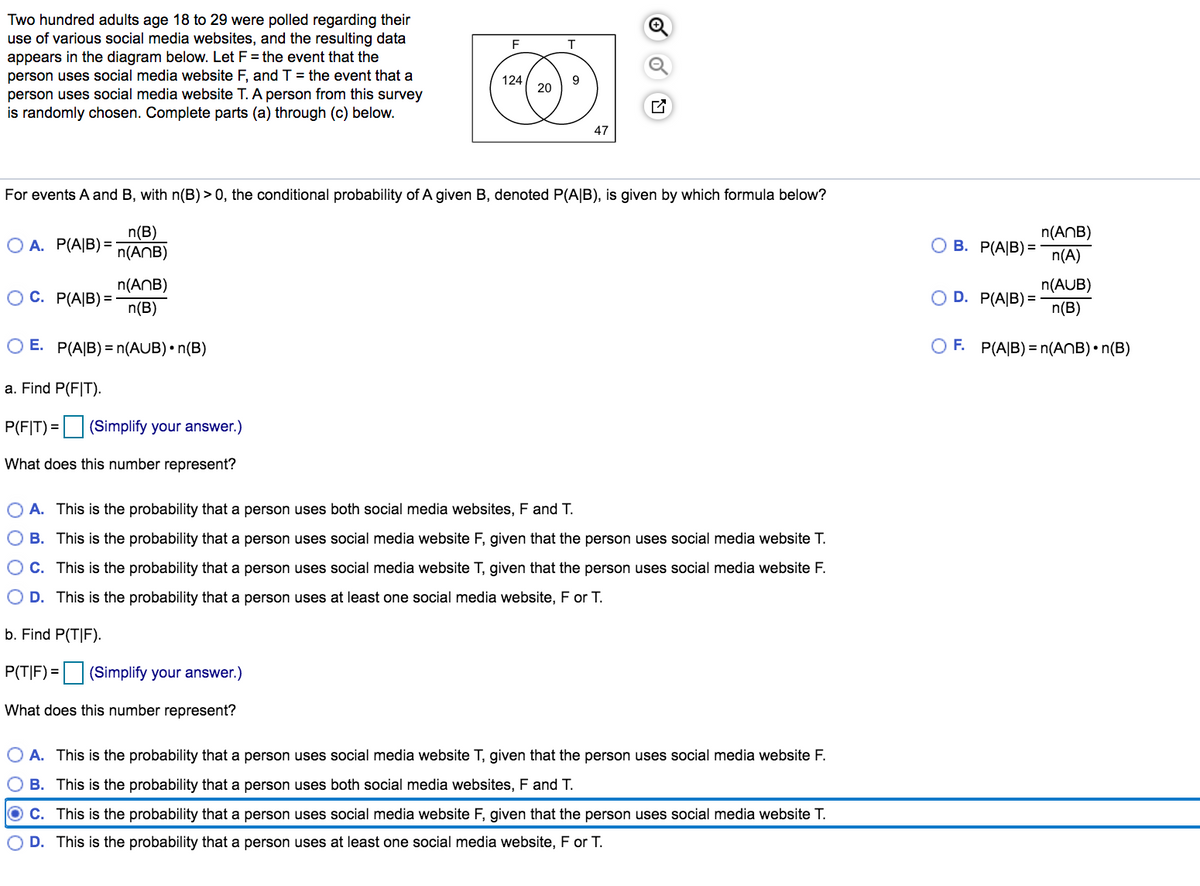Two hundred adults age 18 to 29 were polled regarding their use of various social media websites, and the resulting data appears in the diagram below. Let F = the event that the person uses social media website F, and T = the event that a person uses social media website T. A person from this survey is randomly chosen. Complete parts (a) through (c) below. 124 20 47 For events A and B, with n(B) > 0, the conditional probability of A given B, denoted P(A|B), is given by which formula below? n(B) n(ANB) O A. P(A|B) = n(ANB) O B. P(A|B) = n(A) n(AUB) n(B) n(ANB) OC. P(A|B) = n(B) O D. P(A|B) = O E. P(A|B) = n(AUB) • n(B) O F. P(A|B) = n(ANB) • n(B) a. Find P(F|T). P(F|T) = (Simplify your answer.) What does this number represent? O A. This is the probability that a person uses both social media websites, F and T. O B. This is the probability that a person uses social media website F, given that the person uses social media website T. OC. This is the probability that a person uses social media website T, given that the person uses social media website F. O D. This is the probability that a person uses at least one social media website, F or T. b. Find P(T|F). P(T|F) = (Simplify your answer.) What does this number represent? O A. This is the probability that a person uses social media website T, given that the person uses social media website F. O B. This is the probability that a person uses both social media websites, F and T. O C. This is the probability that a person uses social media website F, given that the person uses social media website T. O D. This is the probability that a person uses at least one social media website, F or T.
Correlation
Correlation defines a relationship between two independent variables. It tells the degree to which variables move in relation to each other. When two sets of data are related to each other, there is a correlation between them.
Linear Correlation
A correlation is used to determine the relationships between numerical and categorical variables. In other words, it is an indicator of how things are connected to one another. The correlation analysis is the study of how variables are related.
Regression Analysis
Regression analysis is a statistical method in which it estimates the relationship between a dependent variable and one or more independent variable. In simple terms dependent variable is called as outcome variable and independent variable is called as predictors. Regression analysis is one of the methods to find the trends in data. The independent variable used in Regression analysis is named Predictor variable. It offers data of an associated dependent variable regarding a particular outcome.
|
Two hundred adults age 18 to 29 were polled regarding their use of various social media websites, and the resulting data appears in the diagram below. Let
F=the
event that the person uses social media website F, and T = the event that a person uses social media website T. A person from this survey is randomly chosen. Complete parts (a) through (c) below. |
|


Trending now
This is a popular solution!
Step by step
Solved in 4 steps with 4 images








